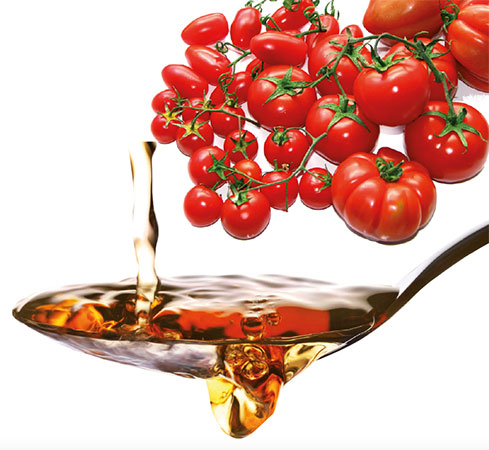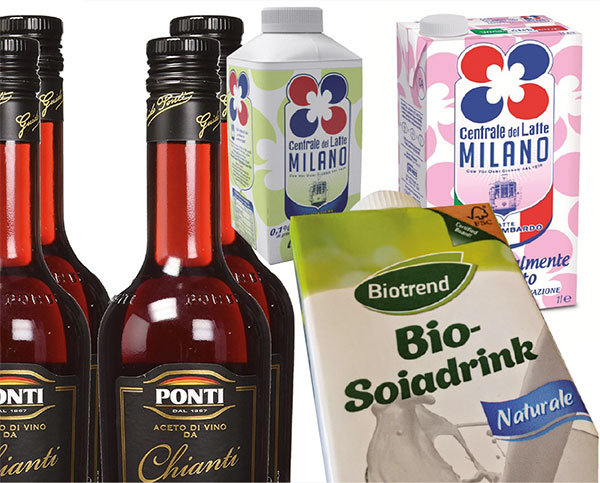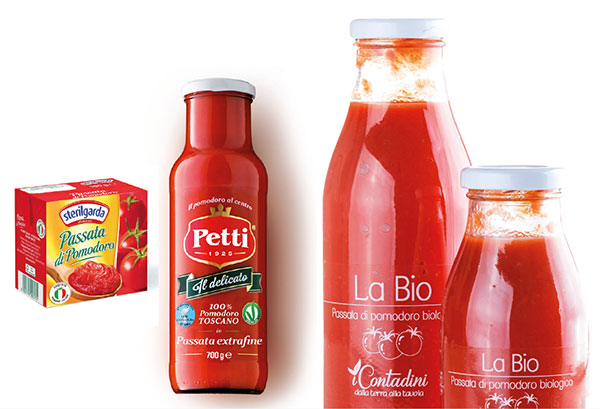Notes on market performance and packaging mix
Liquid food

According to a report by the Istituto Italiano Imballaggio database, liquid food includes condiments, food oil, vinegar, bovine milk for consumption (excluding that used in the food industry) and various tomato products, namely sauces, pastes and ketchup (and Italy’s own “salsa rubra”, Editor’s note*).
The last item on that list is included in the category of liquid food because the packaging that it uses breaks down along similar lines.
The entire sector’s 2016 production exceeded 5,500 t/000; according to the latest Istat estimates, that production’s value exceeds 7,400 million euro.
In quantitative terms, 47% of the sector is constituted by milk, followed by 31% of tomato products. 11% of liquid food is olive oil, while 9% is made up of seed oils and the remaining 3% by vinegar.

Sectors at a glance
Olive oil. Early attacks by olive oil fruit flies have made 2016-2017 a disastrous year for crops, with a 62% drop in Italy’s total olive oil production. A much more abundant season is forecasted for next year, although worries persists concerning the rate of recovery. Hopes for a return to normal levels have been scaled back in the face of climate issues (harsh winters followed by icy springs and summer drought) and concerns about pests. During the first half of 2017, exports dropped 20%, while imports grew by 13%. Consumption should see approximately 1% growth.
Seed oils. According to Istat data referring to 2016, production of seed oils - largely destined for the domestic market - grew by 6% over 2015, while exports remained stable.
According to preliminary Ismea-Nielsen estimates, the first six months of 2017 saw a certain stability in consumption of seed oils in the home, with exports dropping by 3%.
Bovine milk. In 2016, 2,603 mln lt of bovine milk was produced for the end consumer market, representing a drop compared to the previous year by 3%. Even greater has been the drop in consumption of over 4%, largely due to the growing popularity of plant-based substitutes (tied to the spreading phenomenon of lactose intolerance).
Consumption of rice-, almond-, oat- and soy-based drinks (which fall under the category of “wellness drinks”, making them best thought of as a beverage in the narrow sense) grew in 2016 by 13%. In 2017, the negative trend of bovine milk continued, increasingly feeling the pressure of competition with plant-based products, dropping 4% during the first six months, compared to the same period during the previous year. Production is nonetheless sustained by exports, which are compensating for the bad year for the domestic market.

Vinegar. In recent years, Italy’s vinegar consumption has seen gradual growth, with +1% by volume in 2016 (Istat). The trend has been driven in 2016 by two factors: on one hand, the double-digit growth (+11%) of cider vinegar and, on the other, the recovering consumption of classic wine vinegar.
These two phenomena are especially tied to household consumption, because in restaurants it is above all Modena balsamic that is driving growth, even as it loses points in the household market (-5.3%).
Cider vinegar’s success is closely tied to Italians’ increasingly conspicuous healthy choices. This is also why, just as in other food segments, they are increasingly turning to organic options in their vinegar.
Total production in 2016, including that destined for use in the food industry, stood at 675 mln lt, 147 mln of which destined for the home. Exports grew by over 3%, while imports grew by 10% (but in this case the products are used almost exclusively by the food industry).

Tomato products (pastes, sauces, ketchup). This category includes a collection of tomato products that in terms of weight exceeded 1,700 t/000 in 2016, with a 3% growth rate. The positive trend can be attributed to the strong performance of tomato sauces (4% growth in 2016), but also exports of all tomato-derived products, especially sauces, which grew by 5%, along with crushed tomatoes at +1%.
The packaging mix
• According to an analysis of packaging totals, 40% of that used for this category consists in rigid and primarily paper polylaminate containers, 91% of which referable to the milk market.
• Glass bottles stand at 22%, with very strong representation in tomato products, olive oil and vinegar. In recent years there has also been a slight move to bring back fresh milk in glass.
• Next are PET bottles, with 20%, largely attributable to seed oils and milk.
• Steel cans make up 14% of the packaging mix. They are mainly used for packaging olive oil and tomato products.
• The remaining 4% of products fall under the generic category “Other”, which includes bag-in-box solutions (used for oil and vinegar) and flexible polylaminate pouches, used for single portions of condiments and ketchup.
In this sector, the packaging mix has been fairly stable for some time now, along with market shares. Any major substitutions of one packaging solution for another have virtually entirely to do with marketing decisions.
* FUN FACT Popular legend tells that Italy’s “salsa rubra” derives its name from a contest put on by Cirio during the 1930s to find an Italian word for ketchup. In actuality, Cirio has marketed its own brand of salsa rubra since the late 1800s (as the product’s label says), which is a mass produced version of the Piedmontese “bagnet ross”. (Source: Wikipedia)
Barbara Iascone
Istituto Italiano Imballaggio

















